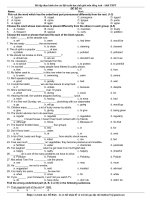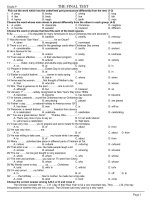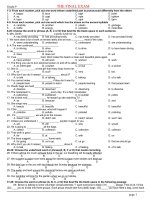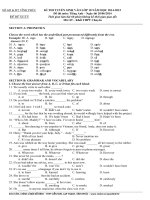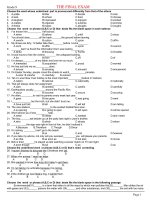đề ôn thi đại học môn tiếng anh lần 1 năm học 2013-2014
Bạn đang xem bản rút gọn của tài liệu. Xem và tải ngay bản đầy đủ của tài liệu tại đây (110.82 KB, 10 trang )
www.DeThiThuDaiHoc.com – Đề Thi Thử Đại Học
Trang 1/8 – Mã đề thi 297
ĐẠI HỌC SƯ PHẠM TP HCM
TRƯỜNG TRUNG HỌC THỰC HÀNH
(Đề thi có 8 trang)
ĐỀ THI THỬ ĐẠI HỌC NĂM 2014
Môn: TIẾNG ANH Khối: D
Thời gian làm bài: 90 phút, không kể thời gian phát đề
Mã đề thi: 297
Choose the word whose underlined part differs from the other three in pronunciation.
1. A. fought B. slaughter C. draught D. naughty
2. A. apprehension B. equation C. precaution D. discretion
3. A. catastrophe B. aborigine C. troupe D. coyote
4. A. moped B. rugged C. hatred D. crooked
5. A. breakfast B. sweat C. breathe D. realm
Choose the word(s) CLOSEST in meaning to the underlined word(s) in each of the
following questions
6. Mr Young, general manager of the emergency response division of AMSA, said that the
debris was spotted along a busy shipping route and could be containers that had fallen off
cargo vessels.
A. seen B. collected C. shot D. analysed
7. Ten years ago the Republic of Ireland became the first country in the world to lay down a
workplace smoking ban.
A. expose B. suggest C. introduce D. propose
Choose the word(s) OPPOSITE in meaning to the underlined word(s) in each of the
following questions
8. I am afraid I haven't allowed him enough initiative, said Father Payne; that's
a bad habit of mine.
A. determination B. encouragement C. beginning D. cowardice
9. He is comparatively gentle with me, but uncontrollable by others.
A. awkward B. ponderous C. well-behaved D. inept
10. My uncle, who is an accomplished guitarist, taught me how to play the guitar.
A. unimpaired B. unqualified C. unskilled D. professional
Read the following passage and mark the letter A, B, C, or D on your answer sheet to indicate the
correct word for each of the blanks from 11 to 20.
Biological diversity has become widely (11)________ as a critical conservation issue only in the past
two decades. The rapid destruction of the tropical rain forests, which are the ecosystems with the
highest known species diversity on Earth, has awakened people to the importance and (12)________ of
biological diversity. The high rate of species extinctions in these environments is jolting, but it is
important to recognize the significance of biological diversity in all ecosystems. As the human
population continues to (13)_______, it will negatively affect one after another of Earth's ecosystems.
In terrestrial ecosystems and in fringe marine ecosystems (such as wetlands), the most common
problem is habitat destruction. In most situations, the result is irreversible. Now humans are beginning
to destroy marine ecosystems through other types of activities, such as disposal and runoff of
www.DeThiThuDaiHoc.com – Đề Thi Thử Đại Học
Trang 2/8 – Mã đề thi 297
poisonous waste; in (14)________ two centuries, by significantly reducing the variety of species on
Earth, they have unraveled cons of evolution and irrevocably redirected its course.
Certainly, there have been (15)________ in Earth's history when mass extinctions have occurred. The
extinction of the dinosaurs was caused by some physical event, either climatic or cosmic. There have
also been less dramatic extinctions, as when natural competition between species (16)________ an
extreme conclusion. Only 0.01 percent of the species that have lived on Earth have survived to the
present, and it was largely chance that (17)________ which species survived and which died out.
However, nothing has ever equaled the magnitude and speed with which the human species is altering
the physical and chemical world and (18)_________ the environment. In fact, there is wide agreement
that it is the rate of change humans are (19)_________, even more than the changes themselves, that
will lead to biological devastation. Life on Earth has continually been (20)_________ flux as slow
physical and chemical changes have occurred on Earth, but life needs time to adapt - time for
migration and genetic adaptation within existing species and time for the proliferation of new genetic
material and new species that may be able to survive in new environments.
11. A. popularized B. recognized C. acquired D. agreed
12. A. destruction B. attack C. fragility D. violence
13. A. expand B. spread C. reach D. deteriorate
14. A. fewer than B. less than C. more than D. worse than
15. A. times B. species C. periods D. changes
16. A. drew B. led C. reached D. came
17. A. determined B. approved C. affected D. considered
18. A. defending B. decreasing C. detecting D. demolishing
19. A. contaminating B. deflecting C. conflicting D. inflicting
20. A. of B. on C. through D. in
Choose the correct answer to each of the following questions.
21. Once they have finished the extension to the factory, there will be room for them to -
_______ a lot more workers.
A. come up B. go over C. take on D. run for
22. The head of the research lab ____________ with his boss over pay for the people who
worked there.
A. fell out B. got on C. came up D. run away
23. The discovery of oil brought wealth to the country.
A. unsaid B. untold C. undeclared D. unannounced
24. Born into a very rich family, he has for nothing.
A. wanted B. needed C. lacked D. required
25. She is afraid that her youngest son has never been particularly quick on the .
A. upshot B. upturn C. upkeep D. uptake
26. Why does he need to make such heavy
of a simple task?
A. climate B. weather C. storm D. cloud
www.DeThiThuDaiHoc.com – Đề Thi Thử Đại Học
Trang 3/8 – Mã đề thi 297
27. I’m very tired, what travelling all day yesterday and having a disturbed right.
A. on B. of C. for D. with
28. Claims for compensation could run into millions of dollars.
A. well B. much C. far D. likely
29. You can imagine how upset I was after the closure of the magazine. Since the first day on
its staff I it was my best job ever.
A. had considered B. have considered C. considered D. was considered
30. He left without a word. If only he something.
A. said B. had said C. was saying D. says
31. Wasn’t it you the door open?
A. left B. had left C. to have left D. who left
32. in English having more than one meaning.
A. There are many a words B. There is an amount of words
C. There are a great many words D. There are a few of words
33. We had people applying for the job.
A. many B. any amount of C. many of D. only few
34. I’d sooner they deliver the new furniture tomorrow.
A. won’t B. wouldn’t C. shouldn’t D. didn’t
35. The new chief executive moves that a daring innovation .
A. will be considered B. is considered
C. be considered D. was considered
36. I’ve yet as John.
A. to meet as kind a person B. to have met such a kind person
C. met so kind a person D. not met such a kind person
37. In a room window is wide open .
A. where / a young artist lives B. whose / lives a young artist
C. its / does a young artist live D. the / lives a young artist
38. “Who is Susan getting married to?” “Oh, some guy since childhood.”
A. she has known B. has been known
C. has known her D. who has been known
39. as taste is really a composite sense made up of both taste and smell.
A. That we refer to B. What we refer to
C. To which we refer D. Whether do we refer
40. There no price rises till the end of the year. Because of this, we will have to
change the name of the product before we can sell it for more money.
A. will have been B. are
C. are to be D. won’t be
41. She is not really looking forward to this weekend, when she a family
reunion.
A. has attended B. has been attending
C. will have to attend D. would be able to attend
42. I don’t think he will join us, ?
A. doesn’t he B. won’t he
C. will he D. do I
43. She made it clear that under no circumstances
this trip.
A. she would cancel B. she cancelled
www.DeThiThuDaiHoc.com – Đề Thi Thử Đại Học
Trang 4/8 – Mã đề thi 297
C. would she cancel D. did she cancel
44. Mary: Don’t fail to send your parents my regards.
Jane: .
A. You’re welcome B. Good idea, thanks
C. It’s my pleasure D. Thanks, I will
45. “She’s a violent woman.”
“ . She’s hit me more than once.”
A. You can say that again B. You don’t say!
C. I wouldn’t say no D. What would you say?
Choose the underlined part that needs correction.
46. Because of the expense of traditional fuels and the concern that they run out, many
A B C
countries have been investigating a alternative sources of power.
D
47. Some so-called health foods are not so healthy; many are made with oils that rise
A B C D
cholesterol levels.
48. It is said that Einstein feels very bad about the application of his theories to the creation
A B C D
of weapons of war.
49. Emotions are complicated psychological phenomena those we cannot sum up in everyday
A B C D
terms.
50. Not until much later did she realize that her long-known partner had been lying her.
A B C D
Read the following passage and mark the letter A, B, C, or D on your answer sheet to indicate the
correct answer to each of the questions from 51 to 59.
The ocean bottom – a region nearly 2.5 times greater than the total land area of the
Earth – is a vast frontier that even today is largely unexplored and uncharted. Until
about a century ago, the deep-ocean floor was completely inaccessible, hidden beneath
Line waters averaging over 3,600 meters deep. Totally without light and subjected to intense
(5) pressures hundreds of times greater than at the Earth's surface, the deep-ocean bottom
is a hostile environment to humans, in some ways as forbidding and remote as the void
of outer space.
Although researchers have taken samples of deep-ocean rocks and sediments for
over a century, the first detailed global investigation of the ocean bottom did not
(10) actually start until 1968, with the beginning of the National Science Foundation's Deep
Sea Drilling Project (DSDP).Using techniques first developed for the offshore oil and
gas industry, the DSDP's drill ship, the Glomar Challenger, was able to maintain a
steady position on the ocean's surface and drill in very deep waters, extracting samples
of sediments and rock from the ocean floor.
(15) The Glomar Challenger completed 96 voyages in a 15-year research program that
ended in November 1983. During this time, the vessel logged 600,000 kilometers and
took almost 20,000 core samples of seabed sediments and rocks at 624 drilling sites
www.DeThiThuDaiHoc.com – Đề Thi Thử Đại Học
Trang 5/8 – Mã đề thi 297
around the world. The Glomar Challenger's core samples have allowed geologists
to reconstruct what the planet looked like hundred of millions of years ago and to
(20) calculate what it will probably look like millions of years in the future. Today, largely
on the strength of evidence gathered during the Glomar Challenger's voyages, nearly
all earth scientists agree on the theories of plate tectonics and continental drift that
explain many of the geological processes that shape the Earth.
The cores of sediment drilled by the Glomar Challenger have also yielded
(25) information critical to understanding the world's past climates. Deep-ocean sediments
provide a climatic record stretching back hundreds of millions of years, because they
are largely isolated from the mechanical erosion and the intense chemical and biological
activity that rapidly destroy much land-based evidence of past climates. This record has
already provided insights into the patterns and causes of past climatic change –
(30) information that may be used to predict future climates.
51. The author refers to the ocean bottom as a "frontier" in line 2 because it _______
A. is not a popular area for scientific research
B. contains a wide variety of life forms
C. attracts courageous explorers
D. is an unknown territory
52. The word "inaccessible" in line 3 is closest in meaning to _______
A. unrecognizable B. unreachable C. unusable D. unsafe
53. The author mentions outer space in line 7 because _______
A. the Earth's climate millions of years ago was similar to conditions in outer space.
B. it is similar to the ocean floor in being alien to the human environment
C. rock formations in outer space are similar to those found on the ocean floor
D. techniques used by scientists to explore outer space were similar to those used in ocean
exploration
54. Which of the following is true of the Glomar Challenger?
A. It is a type of submarine. B. It is an ongoing project.
C. It has gone on over 100 voyages D. It made its first DSDP voyage in 1968
55. The word " extracting " in line 13 is closest in meaning to _______
A. breaking B. locating C. removing D. analyzing
56. The deep Sea Drilling Project was significant because it was _______
A. an attempt to find new sources of oil and gas
B. the first extensive exploration of the ocean bottom
C. composed of geologists form all over the world
D. funded entirely by the gas and oil industry
57. The word "strength" in line 21 is closest in meaning to _______
A. basis B. purpose C. discovery D. endurance
58. The word "they" in line 26 refers to _______
A. years B. climates C. sediments D. cores
59. Which of the following is NOT mentioned in the passage as being a result of the Deep Sea
Drilling Project?
A. Geologists were able to determine the Earth's appearance hundreds of millions of years ago.
B. Two geological theories became more widely accepted
C. Information was revealed about the Earth's past climatic changes.
www.DeThiThuDaiHoc.com – Đề Thi Thử Đại Học
Trang 6/8 – Mã đề thi 297
D. Geologists observed forms of marine life never before seen.
Read the following passage and mark the letter A, B, C, or D on your answer sheet to indicate the
correct answer to each of the questions from 60 to 70.
Iron production was revolutionized in the early eighteenth century when coke was
first used instead of charcoal for refining iron ore. Previously the poor quality of the
iron had restricted its use in architecture to items such as chains and tie bars for
Line supporting arches, vaults, and walls. With the improvement in refining ore, it was now
(5) possible to make cast-iron beams, columns, and girders. During the nineteenth century
further advances were made, notably Bessemer's process for converting iron into steel,
which made the material more commercially viable.
Iron was rapidly adopted for the construction of bridges, because its strength was far
greater than that of stone or timber, but its use in the architecture of buildings developed
(10) more slowly. By 1800 a complete internal iron skeleton for buildings had been developed
in industrial architecture replacing traditional timber beams, but it generally remained
concealed. Apart from its low cost, the appeal of iron as a building material lay in its
strength, its resistance to fire, and its potential to span vast areas. As a result, iron
became increasingly popular as a structural material for more traditional styles of
(15) architecture during the nineteenth century, but it was invariably concealed.
Significantly, the use of exposed iron occurred mainly in the new building types
spawned by the Industrial Revolution: in factories, warehouses, commercial offices,
exhibition hall, and railroad stations, where its practical advantages far outweighed its
lack of status. Designers of the railroad stations of the new age explored the potential
(20) of iron, covering huge areas with spans that surpassed the great vaults of medieval
churches and cathedrals. Paxton's Crystal Palace, designed to house the Great
Exhibition of 1851, covered an area of 1.848 feet by 408 feet in prefabricated units of
glass set in iron frames. The Paris Exhibition of 1889 included both the widest span
and the greatest height achieved so far with the Halle Des Machines, spanning 362 feet,
(25) and the Eiffel Tower 1,000 feet high. However, these achievements were mocked by
the artistic elite of Paris as expensive and ugly follies. Iron, despite its structural
advantages, had little aesthetic status. The use of an exposed iron structure in the
more traditional styles of architecture was slower to develop.
60. What does the passage mainly discuss?
A. Advances in iron processing in the eighteenth and nineteenth centuries
B. The effects of the Industrial Revolution on traditional architectural styles
C. Advantages of stone and timber over steel as a building material
D. The evolution of the use of iron in architecture during the 1800's
61. The word "revolutionized" in line 1 is closest in meaning to _______
A. quickly started B. gradually opened
C. dramatically changed D. carefully examined
62. According to the passage, iron was NOT used for beams, columns, and girders prior to the
early eighteenth century because _______
A. all available iron was needed for other purposes
B. limited mining capability made iron too expensive
www.DeThiThuDaiHoc.com – Đề Thi Thử Đại Học
Trang 7/8 – Mã đề thi 297
C. iron was considered too valuable for use in public buildings
D. the use of charcoal for refining ore produced poor quality iron
63. Iron replaced stone and timber in the building of bridges because iron was considered ______
A. more beautiful B. new and modern
C. much stronger D. easier to transport
64. The word "it" in line 11 refers to _______
A. industrial architecture B. internal iron skeleton
C. stone D. strength
65. The word "spawned" in line 17 is closest in meaning to _______
A. created B. maintained C. rejected D. exposed
66. The word "surpassed" in line 20 is closest in meaning to _______
A. imitated B. exceeded C. approached D. included
67. According to paragraph 3, the architectural significance of the Halle Des Machines was its
_______
A. wide span B. great height
C. unequaled beauty D. prefabricated unites of glass
68. How did the artistic elite mentioned in the passage react to the buildings at the Paris
Exhibition?
A. They tried to copy them. B. They ridiculed them.
C. They praised them. D. They refused to pay to see them.
69. It can be inferred that the delayed use of exposed iron structures in traditional styles of
architecture is best explained by the _______
A. impracticality of using iron for small, noncommercial buildings
B. association of iron architecture with the problems of the Industrial Revolution
C. general belief that iron offered less resistance to fire and harsh weather than traditional
materials
D. general perception that iron structures were not aesthetically pleasing
70. The paragraph following the passage most probably discusses _______
A. the gradual inclusion of exposed iron in traditional styles of architecture
B. further improvements in iron processing methods
C. the return to traditional building materials for use in commercial structures
D. the decreased use of stone and timber as a building material
Choose the sentence that is closest in meaning to each of the following questions.
71. He’d rather that you paid him immediately.
A. He’d rather to be paid by you immediately.
B. He’d sooner you to pay him immediately.
C. He refers being paid by you immediately.
D. He’d prefer you to pay him immediately.
72. I guess that Bob forgot the whole event.
A. The whole event is no longer mentioned by both of us.
B. Bob appears to have forgotten the whole event.
C. Bob must have forgotten the whole event.
D. Nothing about the event is worth remembering.
73. We sent out the invitations as soon as the date of the party was chosen.
A. After choosing the date of the party, our invitations were sent out.
www.DeThiThuDaiHoc.com – Đề Thi Thử Đại Học
Trang 8/8 – Mã đề thi 297
B. We sent out the invitations immediately after choosing the date of the party.
C. Hardly the date of the party was chosen when our invitations were sent out.
D. We had only just sent out the invitations when the date of the party was chosen.
74. We had to put off our wedding until September.
A. It was not until September that our wedding had to be put off.
B. Not until September did we have to put off our wedding.
C. Our wedding had to be postponed until September.
D. Our wedding would be organized only after September.
75. I was going to leave, but because of what she said, I didn’t.
A. She talked me out of leaving.
B. I was told not to leave.
C. It was said that I was not going to leave.
D. I was not going to leave because of her.
76. It’s no use talking to her because she’ll do as she pleases whatever we say.
A. It makes no difference who talks to her because she refuses to listen to either of us.
B. Nothing we can say will make her change her ways, so it’s pointless for us to say
anything.
C. She only cares about herself and never talks to either of us.
D. We’ve told her that it’s not useful, and we don’t need to say anything more about it.
77. She strikes me as a very efficient teacher.
A. I make an effective impression on her as a teacher.
B. As a teacher, she strikes me efficiently.
C. My impression of her is that she is a very efficient teacher.
D. She is such an effective teacher that she always strikes her students.
78. Because the evidence was withheld, the accused was found guilty.
A. If the evidence was withheld, the accused would be found guilty.
B. If the evidence wasn’t withheld, the accused wouldn’t be found guilty.
C. If the evidence wasn’t withheld, the accused would be acquitted of the charge.
D. Had the evidence been presented, the accused would have been acquitted.
79. Many countries share the news that drastic measures must be taken to stop the pollution
of the seas.
A. The pollution of the seas can only be prevented provided that many countries follow
the same policy.
B. By putting into practice a series of precautions, it is generally believed that the
pollution of the seas will be prevented.
C. A lot of countries agree that it is essential to take strong action to put an end to the
pollution of the seas.
D. The seas will, it seems, continue to be polluted unless this agreement is accepted by a
majority of the countries.
80. She will marry him whether he is rich or poor.
A. Be he rich or poor, she will marry him.
B. She will marry him however poor he may be.
C. She wants to marry him if he is rich.
D. She doesn’t want to marry him because he is poor.
THE END
www.DeThiThuDaiHoc.com – Đề Thi Thử Đại Học
Trang 9/8 – Mã đề thi 297
ĐẠI HỌC SƯ PHẠM TP HCM
TRƯỜNG TRUNG HỌC THỰC HÀNH
ĐÁP ÁN
ĐỀ THI THỬ ĐẠI HỌC NĂM 2014
Môn: TIẾNG ANH Khối: D
CÂU 166 297 384 765
1.
D C D C
2.
B B C B
3.
B C C C
4.
C A C A
5.
A C A C
6.
B A B A
7.
C C A C
8.
D D D D
9.
C C B C
10.
A C D C
11.
D B A C
12.
C C A A
13.
C
A
B B
14.
C B D A
15.
A C C D
16.
B C B B
17.
A A D D
18.
D D C A
19.
B D A A
20.
D D B B
21.
A C A D
22.
A A B C
23.
B B C B
24.
D A C D
25.
C D C C
26.
B B C A
27.
D D D B
28.
C A C A
29.
A A D B
30.
B B B C
31.
A D C C
32.
B C A C
33.
C B C C
34.
C D A D
35.
C C C A
36.
C A C C
37.
D B D D
38.
A A B B
39.
C B C C
40.
B C D D
41.
C C D D
42.
A C B B
43.
C C B B
44.
A D C C
www.DeThiThuDaiHoc.com – Đề Thi Thử Đại Học
Trang 10/8 – Mã đề thi 297
45.
C A A A
46.
C C B B
47.
D D C C
48.
B B D D
49.
C C C C
50.
D D A A
51.
D D B D
52.
C B C C
53.
D B A D
54.
C D B C
55.
B C C B
56.
A B C A
57.
B A A B
58.
A C D A
59.
B D D B
60.
D D D D
61.
A C D A
62.
D D B B
63.
B C B C
64.
B B D
A
65.
D A C B
66.
C B B C
67.
B A A C
68.
A B C A
69.
C D D D
70.
D A D D
71.
B D C D
72.
C B D D
73.
A B C B
74.
B C B B
75.
C A A D
76.
C B B C
77.
A C A B
78.
D D B A
79.
D C D C
80.
D A A D





